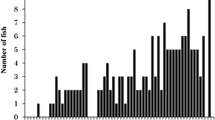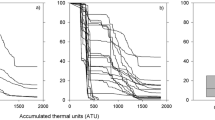Abstract
Thermally selected male rainbow trout selectively bred at high temperatures were crossed with females of the Nikko strain with normal thermal tolerance. The F2 pedigrees, comprising 1641 individuals, were divided into 26 batches. The fish were acclimated to 17 °C, then their thermal tolerance determined by measuring the effective time (ET) required for them to lose equilibrium at an approximate upper lethal temperature (28 °C). The fish were categorized into 0- to < 20-, 20- to < 40-, 40- to < 60-, and ≤ 60-min ET groups. The individuals that survived the first treatment were subjected to a second experiment to determine the ET again for their respective groups. High reproducibility, i.e., 100%, for the 0- to < 20-min ET group was observed in the third experiment for individuals grouped into this ET category in the second experiment; 85.5% of individuals classified into the ≤ 60-min ET in the first experiment were recovered in the second experiment. Thus, our findings demonstrate that ET is a useful indicator for discriminating phenotypes according to their thermal tolerance.







Similar content being viewed by others
References
Cox DK (1974) Effects of three heating rates on the critical thermal maximum of bluegill. In: Gibbons JW, Sharitz RR (eds) Thermal Ecology Conference 730505. National Technical Information Service, Springfield, pp 158–163
Currie RJ, Bennett WA, Beitinger TL (1998) Critical thermal minima and maxima of three freshwater game-fish species. Environ Biol Fishes 51:187–200
Danzmann RG, Jackson TR, Ferguson MM (1999) Epistasis in allelic expression at upper temperature tolerance QTL in rainbow trout. Aquaculture 173:45–58
Elliott JM (1981) Some aspects of thermal stress on freshwater teleosts. In: Pickering AD (ed) Stress and fish. Academic Press, London, pp 209–245
Fry FEJ (1947) Effects of the environment on animal activity. University of Toronto Studies in Biology Series 55. Publ Ont Fish Res Lab 68:1–62
Galbreath PF, Adams ND, Martin TH (2004) Influence of heating rate on measurement of time to thermal maximum in trout. Aquaculture 241:587–599
Healy TM, Schulte PM (2012) Factors affecting plasticity in whole-organism thermal tolerance in common killifish (Fundulus heteroclitus). J Comp Physiol B 182:49–62
Ikeguchi K, Ineno T, Itoi S, Kondo H, Kinoshita S, Watabe S (2006) Increased levels of mitochondrial gene transcripts in the thermally selected rainbow trout (Oncorhynchus mykiss) strain during embryonic development. Mar Biotechnol 8:178–188
Ineno T, Tsuchida S, Kanda M, Watabe S (2005) Thermal tolerance of a rainbow trout Oncorhynchus mykiss strain selected by high-temperature breeding. Fish Sci 353(71):767–775
Ineno T, Endo M, Watabe S (2008) Differences in self-feeding activity between thermally selected and normal strains of rainbow trout Oncorhynchus mykiss at high temperatures. Fish Sci 74:372–379
Ineno T, Tamaki K, Yamada K, Kodama R, Tsuchida S, Tan E, Kinoshita S, Muto K, Yada T, Kitamura S, Asakawa S, Watabe S (2018) Thermal tolerance of a thermally selected strain of rainbow trout Oncorhynchus mykiss and the pedigrees of its F1 and F2 generations indicated by their critical thermal maxima. Fish Sci 84:671–679
Ineno T, Tamaki K, Yamada K, Kodama R, Tan E, Kinoshita S, Muto K, Yada T, Kitamura S, Asakawa S, Watabe S (2019) Evaluation of the thermal tolerances of different strains of rainbow trout Oncorhynchus mykiss by measuring the effective time required for loss of equilibrium at an approximate upper lethal temperature. Fish Sci 85:839–845
Jackson TR, Ferguson MM, Danzman RG, Fishback AG, Ihssen PE, O’connell M, Crease TJ (1998) Identification of two QTL influencing upper temperature tolerance in three rainbow trout (Oncorhynchus mykiss) half-sib families. Heredity 80:143–151
Lowe CH, Vance VJ (1955) Acclimation of the critical thermal maximum of the reptile Urosaurus ornatus. Science 122:73–74
Lund SG, Caissie D, Cunjak RA, Vijayan MM, Tuft BL (2002) The effects of environmental heat stress on heat shock mRNA and protein expression in Miramichi Atlantic salmon (Salmo salar) parr. Can J Fish Aquat Sci 59:1553–1562
Ojima N, Mekuchi M, Ineno T, Tamaki K, Kera A, Kinoshita S, Asakawa S, Watabe S (2012) Differential expression of heat-shock proteins in F2 offspring from F1 hybrids produced between thermally selected and normal rainbow trout strains. Fish Sci 78:1051–1057
Perry GML, Danzmann RG, Ferguson MM, Gibson JP (2001) Quantitative trait loci for upper thermal tolerance in outbred strains of rainbow trout (Oncorhynchus mykiss). Heredity 86:333–341
Recsetar MS, Zeigler MP, Ward DL, Bonar SA, Caldwell CA (2012) Relationship between fish size and upper thermal tolerance. Trans Am Fish Soc 141:1433–1438
Sadoul B, Augustinec S, Zimmerd E, Bégoute ML, Vijayana MM (2019) Prediction of long-term variation in offspring metabolism due to BPA in eggs in rainbow trout using the DEB model. J Sea Res 143:222–230
Spaas JT (1960) Contribution to the comparative physiology and genetics of the European salmonidae. III. Temperature resistance at different ages. Hydrobiologia 15:78–88
Tan E, Wongwarangkana C, Kinoshita S, Suzuki Y, Oshima K, Hattori M, Ineno T, Tamaki K, Kera A, Muto K, Yada T, Kitamura S, Asakawa S, Watabe S (2012) Global gene expression analysis of gill tissues from normal and thermally selected strains of rainbow trout. Fish Sci 78:1041–1049
Tsuchida S (1995) The relationship between upper temperature tolerance and final preferendum of Japanese marine fish. J Therm Biol 20:35–41
Acknowledgements
This study was supported in part by a grant from the Ministry of Agriculture, Forestry, and Fisheries of Japan. We thank Dr. Tsuchida of the Marine Ecology Research Institute Central Laboratory for his invaluable advice. The authors declare no conflict of interest. We would like to thank Editage (www.editage.com) for the English language editing of the submitted manuscript.
Author information
Authors and Affiliations
Corresponding author
Additional information
Publisher's Note
Springer Nature remains neutral with regard to jurisdictional claims in published maps and institutional affiliations.
Electronic supplementary material
Below is the link to the electronic supplementary material.
Rights and permissions
About this article
Cite this article
Ineno, T., Yamada, K., Tamaki, K. et al. Determination of thermal tolerance in rainbow trout Oncorhynchus mykiss based on effective time, and its reproducibility for a large number of fish. Fish Sci 86, 767–774 (2020). https://doi.org/10.1007/s12562-020-01447-9
Received:
Accepted:
Published:
Issue Date:
DOI: https://doi.org/10.1007/s12562-020-01447-9




